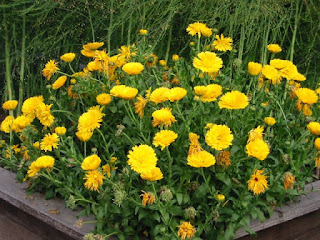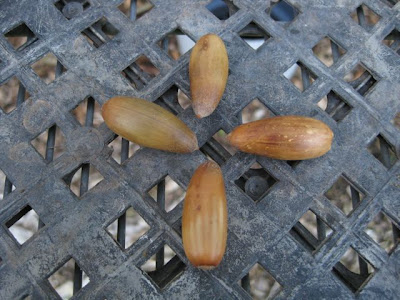The weather forecasters have been teasing us for a couple of weeks lately, predicting the “chance of rain”. So far…not much. However, The Old Farmer’s Almanac is predicting a wet Thanksgiving. The publication, which bases its weather predictions partly on sunspot activity, says the November rainfall will be about three inches above our normal amount of two and a half inches. Overall, however, they are calling for a below-average amount of rainfall for the fall and winter months.
Predictions aside, the persistent Central Valley fog with daytime temperatures hovering in the 40’s is a regular winter visitor to our area. Now's the time to perk up your yard with colorful, easy-to-grow, cool season annuals for these cold, gray months ahead. All of these choices are available now at area nurseries:
Predictions aside, the persistent Central Valley fog with daytime temperatures hovering in the 40’s is a regular winter visitor to our area. Now's the time to perk up your yard with colorful, easy-to-grow, cool season annuals for these cold, gray months ahead. All of these choices are available now at area nurseries:
 |
| Snaps, Iceland Poppies, white alyssum |
• Snapdragons. One of the best cold weather bloomers for sunny areas. Available with yellow, red, pink, or white flowers. A good choice for use as cut flowers. Come in sizes ranging from six inches to 36 inches tall.
• Iceland poppy. These delicate looking flowers
can withstand our harsh fall and winter winds. Iceland poppies get one
to two feet high with flowers available in yellow, white, orange,
salmon, pink, and cream colors. Needs lots of sun for best bloom.
 |
| Too Pretty to Whack |
• Alyssum. This ground cover, which is in bloom nearly year-round, is an easy-to-grow perennial. Give it full sun or light shade, along with moderate water during dry spells. It can self-sow in adjacent areas without asking permission. It also thrives in poor, rocky areas (witness the alyssum that pops up on its own in the sand joints of our brick walkways).
 |
| Calendula |
• Calendulas. Sometimes called the pot marigold, calendulas need lots of sun for their big, two to four inch blooms. Flower colors available include yellow or orange. Calendula plants get from one to two feet high, and make good cut flowers.
• Stock. This fragrant winter annual comes in a wide array of colors including yellow, orange, red, pink, blue, purple, and white. A good flower for cutting. Varieties range from 12 to 30 inches high. Plant in full sun to part shade.
• Stock. This fragrant winter annual comes in a wide array of colors including yellow, orange, red, pink, blue, purple, and white. A good flower for cutting. Varieties range from 12 to 30 inches high. Plant in full sun to part shade.
 |
| Pansies |
• Violas. A large family that includes pansies and Johnny jump-ups. These do well in shady areas and grow six to eight inches high. Available in a multitude of colors, many violas will self-sow year after year.
• Cyclamen. Technically a tuberous-rooted perennial, florists' cyclamen produces star-shaped, red, white, or pink flowers above deep green leaves during the winter. The plant dies back in warm weather, but resprouts each fall. Best in shady areas. Great in pots, in combination with summer bloomers such as impatiens or tuberous begonias.
• Primroses. A perennial in milder climates, best treated as an annual here. The fairy or baby primrose and polyanthus primrose are proven performers for shady areas in the Valley. Primroses produce flowers on 12-inch stems in many hues, including white, pink, rose, red, and lavender.
 • Ornamental kale. As pretty as it is tasty, kale resembles a brightly colored head of cabbage. But it is the green leaves of kale that have the sweet, nut-like flavor. Give them full to part sun as well as regular water.
• Ornamental kale. As pretty as it is tasty, kale resembles a brightly colored head of cabbage. But it is the green leaves of kale that have the sweet, nut-like flavor. Give them full to part sun as well as regular water.
• Cyclamen. Technically a tuberous-rooted perennial, florists' cyclamen produces star-shaped, red, white, or pink flowers above deep green leaves during the winter. The plant dies back in warm weather, but resprouts each fall. Best in shady areas. Great in pots, in combination with summer bloomers such as impatiens or tuberous begonias.
• Primroses. A perennial in milder climates, best treated as an annual here. The fairy or baby primrose and polyanthus primrose are proven performers for shady areas in the Valley. Primroses produce flowers on 12-inch stems in many hues, including white, pink, rose, red, and lavender.
 • Ornamental kale. As pretty as it is tasty, kale resembles a brightly colored head of cabbage. But it is the green leaves of kale that have the sweet, nut-like flavor. Give them full to part sun as well as regular water.
• Ornamental kale. As pretty as it is tasty, kale resembles a brightly colored head of cabbage. But it is the green leaves of kale that have the sweet, nut-like flavor. Give them full to part sun as well as regular water.



